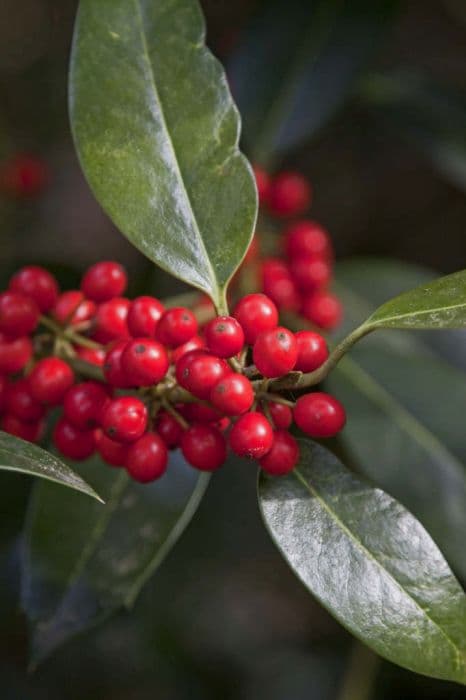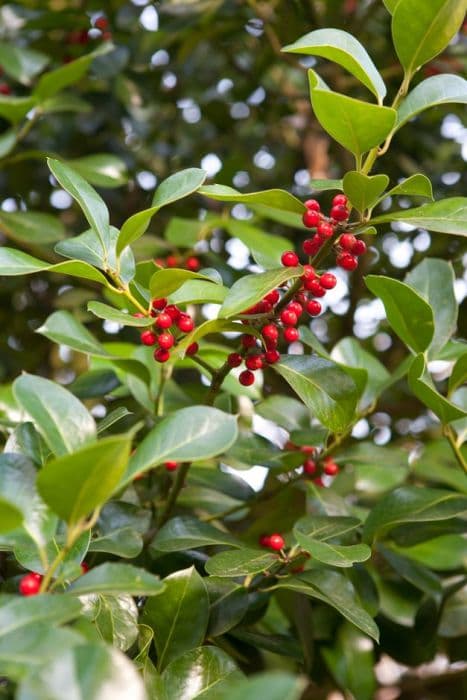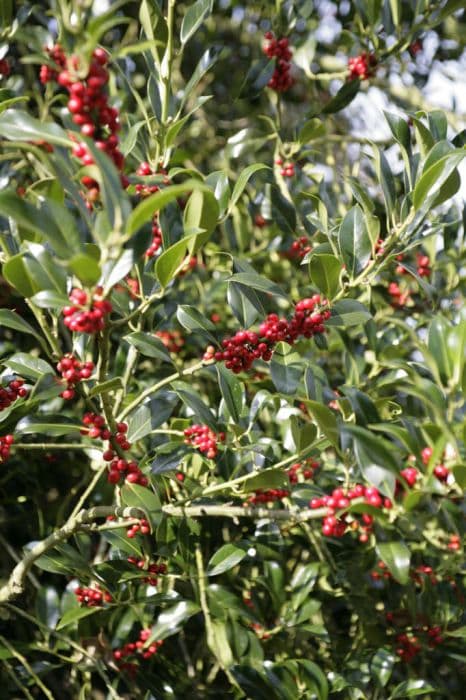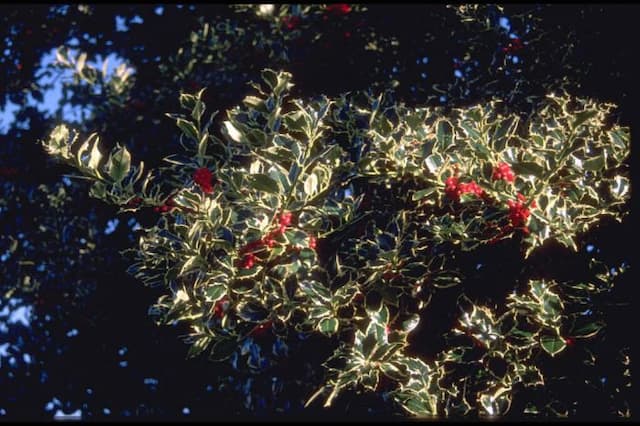Golden King Holly Ilex × altaclerensis 'Golden King' (f/v)

ABOUT
The Golden King holly is a striking evergreen shrub known for its distinctive foliage and berries. It has glossy, variegated leaves that are dark green with broad, bright golden-yellow edges, which can add a splash of color to any garden throughout the year. The leaves are typically shaped with a few spiny points, although they are generally less spiky compared to other holly varieties. Despite its name, the Golden King is actually a female plant, which means it is capable of producing berries. The berries are a vivid red color, adding a contrast against its shiny, variegated leaves. These berries are attractive to birds and can provide a valuable food source during colder months. The overall appearance of the Golden King holly is one of contrasting colors and textures which makes it a popular choice for gardeners looking to create an evergreen focal point without concern for changes in size.
About this plant
 Names
NamesFamily
Aquifoliaceae
Synonyms
Highclere Holly, Golden King Holly
Common names
Ilex × altaclerensis 'Golden King'
 Toxicity
ToxicityTo humans
The Highclere holly is considered mildly toxic if ingested. Its leaves and especially the berries can cause symptoms of gastrointestinal upset, such as nausea, vomiting, and diarrhea, if eaten in significant quantities. The severity of symptoms varies depending on the amount consumed. It is advisable to seek medical attention if ingestion occurs, particularly in children, due to their smaller body size and potentially greater vulnerability to the toxic compounds.
To pets
The Highclere holly is also toxic to pets, including dogs and cats. Similar to its effects on humans, ingestion of the leaves and berries can cause gastrointestinal distress in animals, which may manifest as vomiting, diarrhea, and salivation. If a pet ingests this plant, it is important to contact a veterinarian promptly, as they may require treatment to alleviate symptoms and prevent more serious health complications.
 Characteristics
CharacteristicsLife cycle
Perennials
Foliage type
Evergreen
Color of leaves
Variegated
Flower color
White
Height
8-10 feet (2.4-3 meters)
Spread
8-10 feet (2.4-3 meters)
Plant type
Shrub
Hardiness zones
6
Native area
Cultivar
Benefits
 General Benefits
General Benefits- Ornamental Appeal: The 'Golden King' variety adds aesthetic value to gardens with its attractive variegated leaves.
- Wildlife Habitat: It provides shelter and potentially berries as a food source for birds and other wildlife.
- Low Maintenance: This plant typically requires minimal upkeep once established, making it suitable for various landscape settings.
- Durability: It is known for being robust and can tolerate a range of soil types, urban pollution, and coastal conditions.
- Privacy Screen: Due to its dense growth habit, it can be used effectively as a hedge, screen, or privacy barrier.
- Year-Round Interest: Evergreen nature means it provides color and structure in the garden throughout all seasons.
 Medical Properties
Medical PropertiesThis plant is not used for medical purposes.
 Air-purifying Qualities
Air-purifying QualitiesThis plant is not specifically known for air purifying qualities.
 Other Uses
Other Uses- Privacy Screening: Golden King holly can be used to create a dense, evergreen screen that offers privacy throughout the year due to its thick foliage.
- Topiary Art: The plant can be sculpted into various shapes, making it a great candidate for topiary gardens and artistic landscape designs.
- Windbreaks: Planting Golden King holly in a row can help reduce wind speed in blustery areas, protecting other plants and reducing soil erosion.
- Noise Barrier: The dense growth habit of the holly can help absorb and reduce noise pollution when planted along roads or in urban settings.
- Habitat for Wildlife: Birds enjoy the shelter provided by Golden King holly, and although this particular cultivar does not produce berries, it can still offer protection for birds.
- Foundation Planting: Its structured growth and year-round interest make it a popular choice for planting around the base of buildings to conceal foundations.
- Cultural Symbolism: In some cultures, hollies are used as symbols of protection and good luck, and are incorporated into gardens for these purposes.
- Garden Themes: Golden King holly can be used in themed gardens, such as a winter garden for its evergreen leaves and a formal garden for its neat growth habit.
- Festive Decoration: The leaves of the holly can be used in festive wreaths and arrangements, particularly during the Christmas season.
- Photography Subject: Due to its aesthetic appeal, Golden King holly can serve as a beautiful subject for both professional and amateur photographers especially in garden settings.
Interesting Facts
 Feng Shui
Feng ShuiThe Highclere Holly is not used in Feng Shui practice.
 Zodiac Sign Compitability
Zodiac Sign CompitabilityThe Highclere Holly is not used in astrology practice.
 Plant Symbolism
Plant Symbolism- Protection: Ilex, commonly known as holly, has long been associated with protection due to its spiky leaves, which were believed to ward off evil spirits and negative energies.
- Everlasting Life: Holly is an evergreen plant, symbolizing eternal life and resilience as it remains green throughout the seasons, even in harsh winters.
- Good Fortune: Carrying holly was once thought to bring good luck and is often associated with the festive season, representing hope and joy.
- Foresight: With its sharp leaves, holly is believed to symbolize foresight and the ability to pierce through life's obstacles to achieve clarity and vision.
- Domestic Happiness: Holly is often used in Christmas decorations, symbolizing a time of family gatherings and happiness within the home.
 Water
WaterThe Golden King Holly should be watered thoroughly whenever the top inch of soil feels dry to the touch. This generally equates to watering once or twice a week during its active growth period in spring and summer, tapering to every two or three weeks in the fall and winter. When watering, pour slowly to let the water infiltrate the soil around the roots, using approximately 1 to 2 gallons for a young plant, and more for a mature one, ensuring you are not just wetting the surface but reaching the deeper root zone. Avoid overwatering as this can lead to root rot, a common problem in poorly drained soils. During hot spells or drought, keep a closer eye on moisture levels and water more frequently as needed to maintain consistent soil moisture.
 Light
LightThe Golden King Holly prefers a site with full sun to partial shade. It performs best when it receives at least 4-6 hours of direct sunlight a day, though it can tolerate some light shade, especially in hotter climates. Avoid deep shade as insufficient light can lead to sparser foliage and reduced vigor. The ideal location offers morning sunlight and some protection from harsh afternoon sun, which can scorch the leaves during peak summer months.
 Temperature
TemperatureThe Golden King Holly is hardy and can tolerate a range of temperatures, thriving ideally between 35°F and 75°F. It can survive winter cold down to about -10°F, making it suitable for regions with moderate to cold winters. During extreme summer heat above 90°F, the plant may experience stress, so providing some shade and adequate moisture is beneficial. Overall, this holly prefers a cooler to moderate climate and will flourish within the mentioned temperature ranges.
 Pruning
PruningPruning the Golden King Holly is important for maintaining its shape and encouraging healthy growth. Late winter or early spring, before new growth starts, is the best time for pruning. Snip away any dead or broken branches and shape the plant as desired, keeping in mind that this holly tolerates heavy pruning if reshaping is necessary. For minimal maintenance, simply trim to keep the desired size and remove any crossing branches to prevent damage and disease.
 Cleaning
CleaningAs needed
 Soil
SoilHighclere Holly (Golden King) prefers well-drained, consistently moist soil with a pH range of 5.0 to 6.0. The best soil mix for this plant would be a blend of garden soil, peat moss, and perlite or sand to ensure good drainage and aeration. Organic matter such as compost can also be added to provide nutrients and improve soil structure.
 Repotting
RepottingHighclere Holly (Golden King) should be repotted every 2 to 3 years to refresh the soil and accommodate root growth. However, as it matures and if planted in the ground, repotting is not necessary unless it is being moved to a new location.
 Humidity & Misting
Humidity & MistingHighclere Holly (Golden King) is quite adaptable but prefers moderate humidity levels. It tolerates the average outdoor humidity in most temperate climates well but does not require the high humidity levels that some other plants might.
 Suitable locations
Suitable locationsIndoor
Place in a bright location with indirect light and room temperature.
Outdoor
Plant in a sunny to partly shaded spot with shelter from strong winds.
Hardiness zone
6-9 USDA
 Life cycle
Life cycleHolly 'Golden King' begins its life cycle with seed germination, which requires a period of cold stratification to break dormancy. As a seedling, it establishes a root system and sprouts its first leaves, which are often more ovate and less spiny than mature foliage. Growing into a juvenile plant, it develops its characteristic glossy, variegated leaves and begins to form a woody stem structure. Upon reaching maturity, which may take several years, 'Golden King' produces small white flowers in the spring, though as a female clone, it requires a male pollinator for fertilization. After pollination, the plant develops its distinctive red berries (drupes), which persist through the winter, providing food for birds and wildlife. This plant has an evergreen perennial growth habit, with the cycle of growth, flowering, and berry production repeating annually.
 Propogation
PropogationPropogation time
Early spring
Ilex × altaclerensis 'Golden King', commonly known as the Highclere holly, is best propagated through the semi-hardwood cuttings method. This technique typically takes place during the late summer months, as it is the time when the plant has semi-ripe, new growth that is ideal for cutting. To propagate, a gardener should select healthy, disease-free stems and make cuttings about 4 to 6 inches (10 to 15 centimeters) long, ensuring at least two or three sets of leaves are present. The lower leaves should be removed, and the cut end may be dipped in rooting hormone to encourage root development. The cutting should then be placed in a pot filled with a mixture of peat and perlite or a similar soilless potting mix. The pot should be kept in a well-lit area, out of direct sunlight, and the soil must be kept moist but not saturated until roots have developed, which can take several weeks. This method of propagation is highly favored as it helps maintain the variegated characteristics specific to 'Golden King'.









